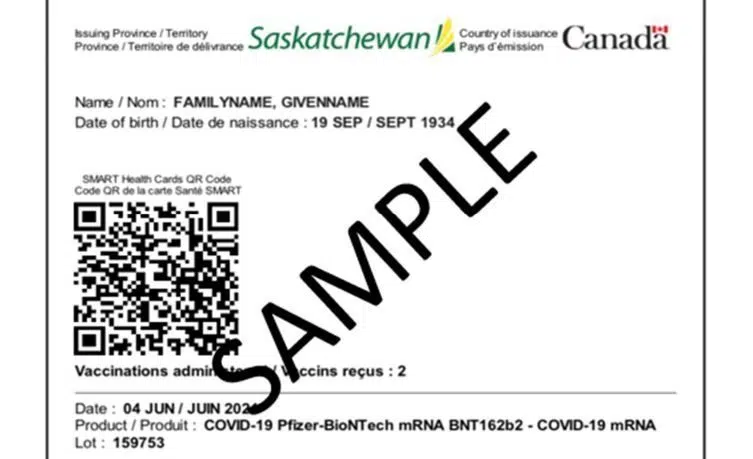A new proof of vaccination option is available to Saskatchewan residents — QR codes.
Any Saskatchewan resident with a MySaskHealthRecord account can now access their COVID-19 vaccination record in a new format that includes a quick response (QR) code.
The code can be downloaded or saved to a mobile device or printed to be presented in physical form for easier access to businesses where access is restricted to those who have been fully vaccinated against COVID-19.
The new format spans the length of a page and replaces the earlier COVID-19 vaccine record launched in the province in August, which did not have a QR code. Embedded in each code is an individual’s vaccination information.
The new QR code format also lists the name, type of vaccine received, date, country of issuance and lot number of each resident.
On Thursday, Premier Scott Moe announced that proof of vaccination or a negative COVID-19 test would be required beginning Oct. 1 to enter various non-essential businesses in the province.
The new code will also support proof of vaccination at border entry for international travel and reportedly aligns with the federal government’s strategy for proof of vaccination.
A verified app is being developed for businesses to read the codes for residents upon entry and is expected to be available by the end of the month. By scanning the QR code, businesses will be able to determine whether an individual has been fully vaccinated before allowing entry.
The Saskatchewan Vaccine Verifier app (SK Vax Verifier) will be free to download from Google Play or Apple App stores. If a green indicator shows after scanning the code, the person has been fully vaccinated; a red indicator would mean they are not.
This information is secure and not viewed, saved or retained in the scanning process.
In a release, Saskatchewan Health Minister Paul Merriman called the code the “next, improved version of Saskatchewan’s COVID-19 vaccination record.
“It has been something that travellers, businesses and organizations have been asking for. With the announcement last week of stronger measures being introduced to help curb the transmission of COVID-19, I encourage anyone eligible for vaccination in Saskatchewan to get their vaccines, and to get their COVID-19 vaccine certificate from MySaskHealthRecord,” he said.
Wallet cards that show vaccines administered to an individual will also be considered acceptable proof of vaccination in accordance with the recent public health measures.
The early launch of the new vaccine certificate is meant to give residents of the province time to familiarize themselves with and access their new proof of vaccination record.
By the end of September, another app — the Saskatchewan Vaccine Wallet app (SK Vax Wallet) — is also expected to be made available for download to the general public. This app will allow Saskatchewan residents to download their vaccine record and have it easily accessible on their phone.
Residents of the province can access their COVID-19 vaccination certificate with the QR code through MySaskHealthRecord on eHealth.
During a news conference Monday, Davin Church — the vice-president of programs and technology at eHealth — explained more about the decision to change the sign-up process.
For one, it’s not permanent.
“We’ve been experiencing significant demand … especially since last week’s announcements provincially,” he began.
“So we have removed (PIN verification), which is an interim process for three or four months … After that, we will reinstate the PIN process. We feel that this will provide quick access to MySaskHealthRecord for citizens, while balancing … other identity information as required.”
He also explained there are other measures to help deal with higher traffic on the website.
eHealth has implemented a new queuing system on MySaskHealthRecord, which only allows a limited number of people online at a time.
“Earlier this morning, the wait time was a little under five minutes … As traffic volumes grow, those wait times will grow, but we believe that they will remain manageable while not impacting the systems and allowing people to continue to access,” he explained.











